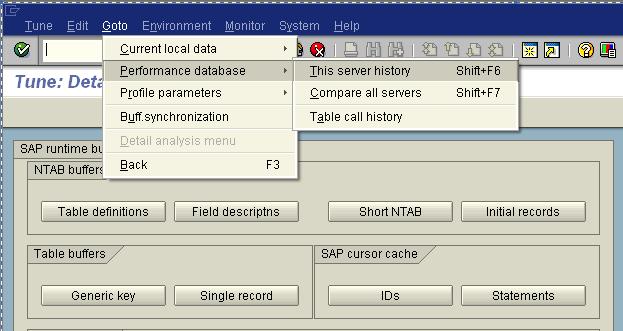| ***************** Index of Pages on the topic…. **************************** |
| 1. SAP Tuning – Gather Symptoms. |
| 2. ST04 – A Magic Transaction for SAP performance tuning – I |
| 3. ST04 – A Magic Transaction for SAP performance tuning – II |
| 4. ST02 – SAP Tuning – Another Magic transaction – I (Part 4) |
| 5. ST02 – SAP Tuning – Important SAP Parameters – II |
| 6. ST03n – The meter gauge for SAP tuning |
| 7. A handy reference for SAP Memory |
| ****************************************************************************** |
|
As I have pointed out earlier the three main points we need to concentrate when dealing with SAP buffer. I am going to discuss one by one of them here.
The first point was whether buffer configuration is correct? To derive the answer on a TOP level is very easy…use transaction ST02 and then if you see any RED highlighted background figures simply say there is some problem and start investigating on that. So which areas one need to concentrate more for? Need to check where swaps are happening? Is it on the SAP Buffer, Memory or in Call statistics?
The thumb rule for call statistics is very easy; the hit ratio must be above 95% for “Select” and “Select Single”.
The thumb rule for Buffer and Memory is if you see a red highlight you increase it using transaction for viewing and changing profiles (RZ10 and/or RZ11). In fact in most of the cases on the web sites discussing about the ways of mitigating these red highlighted areas in ST02 suggest that. But this is not the right approach. One should go thru the history of such buffers for analyzing the situation. Always remember that an ill planned/calculated increase in the
This also needs a simultaneous observation data on the disk I/O, memory I/O and paging activity from the OS side. Requirement is there also to analyze whether your transport schedule are correct or not? Transport activity triggers flushing of SAP buffer. Hence it is always advisable to do transport in the least loaded segment of a day. If you have three-tier architecture with application server a careful observation of SAR reports and trend analysis will show you the same.
Check also the table buffers and the content of the buffers. How many Z table your programmer kept in the buffer? Are they really required? Have you benchmarked the performance of the associated programs before you have buffered the said table? |
 |
|
Some important parameters are listed below as far as changing the parameter is concerned. Use transaction RZ10 and RZ11 for manipulating…Feel this is enough for closing the ST02 topic. Rest everything is depended on the SAP and the Basis Consultaunts intelligence.
|
| ***************** Index of Pages on the topic…. **************************** |
| 1. SAP Tuning – Gather Symptoms. |
| 2. ST04 – A Magic Transaction for SAP performance tuning – I |
| 3. ST04 – A Magic Transaction for SAP performance tuning – II |
| 4. ST02 – SAP Tuning – Another Magic transaction – I (Part 4) |
| 5. ST02 – SAP Tuning – Important SAP Parameters – II |
| 6. ST03n – The meter gauge for SAP tuning |
| 7. A handy reference for SAP Memory |
| ****************************************************************************** |
cool sitename man)))
————————
sponsored link: http://pedeno.ru/
Hello, I can’t understand how to add your blog in my rss reader
————————
ad: http://werato.ru/
for sitemap of my blog add https://soumen.wordpress.com/sitemap.xml
Hi Soumen,
How are you? I hope you are doing well.
Can i have your personal id?
i woild be greatful to you
Thanks
Kiran
kiranind3@gmail.com
9966288045
The best information i have found exactly here. Keep going Thank you
Read the whole series of posts…Wonderful information. Especially the analysis of sap buffers and paging…Great work dude…Keep the good work!!!
Good write-up, I’m normal visitor of one’s blog, maintain up the excellent operate, and It is going to be a regular visitor for a long time.